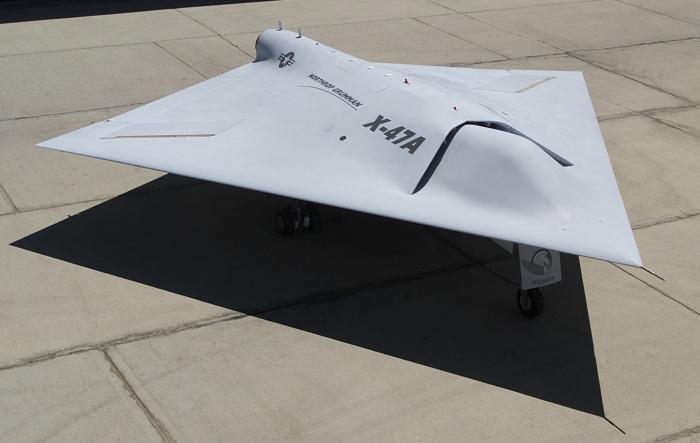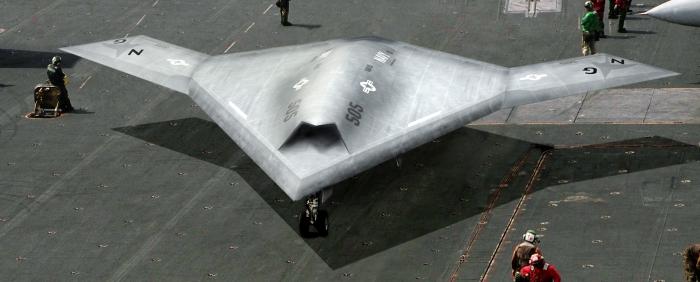Northrop Grumman X-47 Pegasus
In June 2000, the Defense Advanced Research Projects Agency (DARPA) awarded the first study contracts for a carrier-based unmanned combat aircraft - labeled UCAV-N (Unmanned Combat Air Vehicle - Naval) - to Northrop Grumman and Boeing. At that time, Northrop Grumman was already privately developing its Pegasus UCAV demonstrator, which was completed in July 2001. In June, it had received the official military designation X-47A (Boeing's UCAV-N was designated as X-46A). The X-47A was extensively tested on the ground during 2001 and 2002 (including taxiing), and the first flight finally occurred on 23 February 2003.
 |
| Photo: Northrop Grumman |
| X-47A |
The X-47A was a stealth design with no vertical control surfaces, yaw control being achieved by differential movements of surfaces in the wings. The all-composite airframe was powered by a single Pratt & Whitney JT15D turbofan. The vehicle's computer-based control system performed flight control, navigation, mission control and other tasks. The Pegasus was equipped with a U.S. Navy Shipboard Relative GPS navigation system, which would have been necessary for automatic pin-point landings on a moving aircraft carrier deck. On its first flight, the X-47A tested that system by making an exact landing on a pre-designated spot on the runway.
 |
| Photo: Northrop Grumman |
| X-47A |
As it turned out, the first flight of the X-47A remained the only one so far. In April 2003, DARPA combined the UCAV-N program with the on-going USAF/DARPA UCAV program into the joint DARPA/USAF/Navy J-UCAV program, later renamed J-UCAS (Joint Unmanned Combat Air Systems). Northrop Grumman apparently decided that further flight tests of the X-47A would not help the development of its forthcoming J-UCAS demonstrator, designated X-47B.
The airframe of the X-47B has not much in common with that of the X-47A. It is significantly larger, has a more powerful P&W F100 turbofan engine, and redesigned outer wing sections and intake/exhaust configurations. The wing extensions provide for longer range and better low-speed characteristics, and are foldable to reduce parking space on the aircraft carrier. The payload capacity for J-UCAS was to be 2040 kg (4500 lb), representing two GBU-31/B JDAM (Joint Direct Attack Munition) GPS/INS-guided bombs. Northrop Grumman was under contract to build two (originally three) X-47Bs, and flight testing, together with the rival Boeing X-45C, was expected to begin in 2007.
 |
| Composite Photo/CGI: Northrop Grumman |
| X-47B |
The J-UCAS development effort was defined in terms of "spirals". The X-45A UCAV demonstrator was "Spiral 0", while the X-45C and X-47B represented "Spiral 1". Later spirals were to further enhance the mission capabilities of the system by integrating more sensor and weapon options. The ultimate goal had been labeled J-UOS (J-UCAS Objective System) by DARPA.
In early January 2006, the J-UCAS program was cancelled in favor of separate follow-on programs by the USAF and U.S. Navy, and - in case of the Air Force - the development of new manned long-range bomber aircraft. The Navy has since effectively taken over the J-UCAS program under a new label (first N-UCAS, then UCAS-D (Demonstrator)), and parallel development of the X-47B and X-45C vehicles as carrier-based UCAVs continued until mid-2007. In August 2007, the Navy announced the X-47B as the winner of the UCAS-D competition. Primary goal of the six-year X-47B development and evaluation program is the demonstration of launches and recoveries on an aircraft carrier at sea. The completed X-47B was officially unveiled in December 2008, and the first flight of the vehicle is scheduled for late 2009.
Specifications
Note: Data given by several sources show slight variations. Figures given below may therefore be inaccurate!
Data for X-47A/B:
| X-47A | X-47B | |
|---|---|---|
| Length | 8.50 m (27.9 ft) | 11.6 m (38.2 ft) |
| Wingspan | 8.47 m (27.8 ft) | 18.9 m (62.1 ft) |
| Weight (gross) | 2500 kg (5500 lb) | 19000 kg (42000 lb) |
| Speed | Subsonic | High subsonic |
| Ceiling | ? | > 12200 m (40000 ft) |
| Range | ? | 6500 km (3500 nm) |
| Propulsion | Pratt & Whitney JT15D-5C turbofan; 14.2 kN (3190 lb) | Pratt & Whitney F100-PW-220U turbofan; 71.2 kN (16000 lb) |
Main Sources
[1] DARPA J-UCAS Website
[2] Air Force Technology Website
Back to Directory of U.S. Military Rockets and Missiles, Appendix 4
Last Updated: 5 February 2009